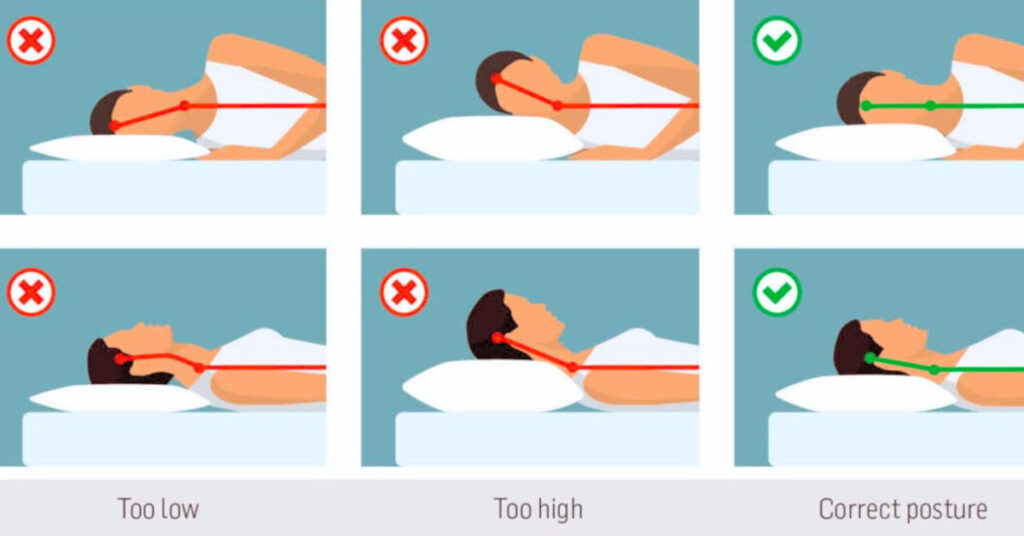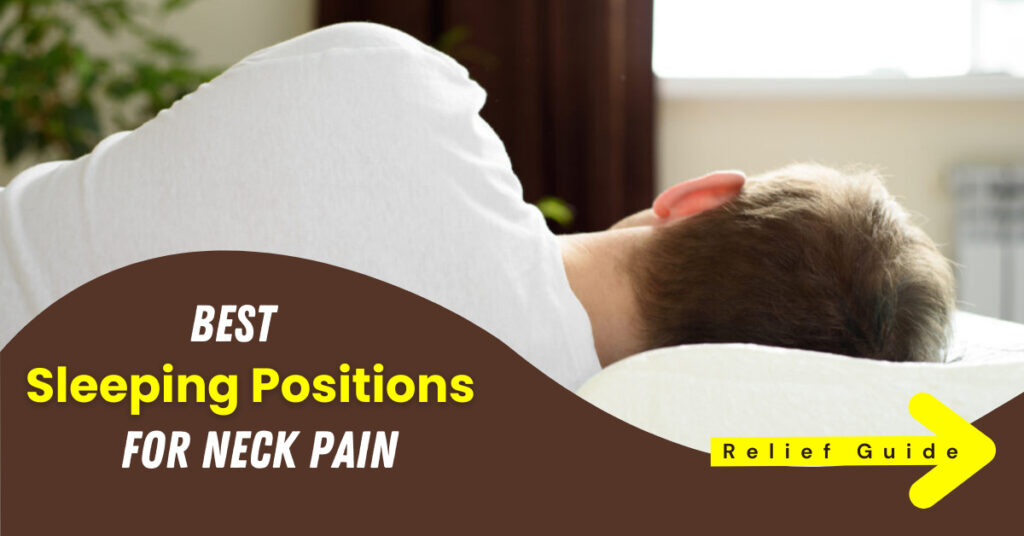Sleeping on your back or side can help alleviate neck pain. Avoid sleeping on your stomach as it strains the neck.
Neck pain can significantly affect your daily life and overall well-being. Finding the right sleeping position is crucial for reducing discomfort and promoting better sleep quality. Back and side sleeping are generally recommended because they maintain proper spinal alignment. Using a supportive pillow that keeps the neck in a neutral position can also be beneficial.
Stomach sleeping, on the other hand, can exacerbate neck pain due to the awkward head angle. Making these small adjustments in your sleeping habits can lead to noticeable improvements in neck pain and overall sleep quality. Prioritize your neck health by choosing supportive sleeping positions and pillows.
Impact Of Sleep On Neck Pain
Neck pain can ruin your sleep. Choosing the right sleeping position is crucial. It can help reduce pain and improve sleep quality. Many people suffer from neck pain due to poor sleep positions. This guide will explore how sleep impacts neck pain. It will also discuss the best positions for relief.
Connection Between Sleep And Pain
Sleep and pain are closely linked. Poor sleep can make pain worse. Good sleep can help reduce pain. Neck pain often comes from bad sleeping positions. Here are some key points:
- Bad posture can strain neck muscles.
- Poor pillow support can cause neck misalignment.
- Twisting and turning can increase neck pain.
Using the right pillow can help. A pillow that supports the neck can reduce pain. The firmness of the mattress also matters. A medium-firm mattress is usually best. Sleeping positions play a big role too. Here’s a quick table of common sleeping positions and their effects on neck pain:
| Sleeping Position | Effect on Neck Pain |
| Back Sleeping | Provides good support, reduces pain |
| Side Sleeping | Can be good with proper pillow support |
| Stomach Sleeping | Often increases neck pain |
Role Of Sleep Quality
Sleep quality is vital for neck pain relief. Good sleep helps the body heal. Poor sleep can make pain worse. Here are some tips for improving sleep quality:
- Use a supportive pillow that keeps the neck aligned.
- Choose a comfortable mattress that supports your body.
- Maintain a consistent sleep schedule by going to bed and waking up at the same time.
Creating a good sleep environment is also important. Make sure your room is dark and quiet. Keep electronic devices away from the bed. Relax before bedtime with a warm bath or reading. These habits can improve sleep quality and reduce neck pain.

Optimal Sleeping Positions
Neck pain can be a real pain, especially when trying to get a good night’s sleep. Finding the right sleeping position is crucial for reducing neck pain and improving sleep quality. Optimal sleeping positions can help align your spine and reduce strain on your neck. Let’s explore the best ways to sleep to ease your neck pain.
Side Sleeping Benefits
Side sleeping is a popular position for many. Sleeping on your side can help keep your spine aligned. This is important for reducing neck pain. To get the most out of side sleeping, follow these tips:
- Use a firm pillow that supports your neck.
- Place a pillow between your knees to keep your hips aligned.
- Keep your head and neck in a neutral position.
Benefits of side sleeping include:
| Benefit | Details |
| Spine Alignment | Helps keep your spine straight and reduces neck strain. |
| Better Breathing | Reduces snoring and improves airflow. |
| Reduced Acid Reflux | Helps keep stomach acid down. |
Side sleeping can be very comfortable. It is important to maintain a good posture. This helps in reducing neck pain over time. Make sure to use the right pillows and supports.
Back Sleeping Advantages
Back sleeping is another good option for those with neck pain. Sleeping on your back helps distribute your weight evenly. This can reduce pressure on your neck. Follow these tips for back sleeping:
- Use a thin pillow to keep your neck aligned.
- Place a pillow under your knees for extra support.
- Keep your arms at your sides or on your stomach.
Advantages of back sleeping include:
| Advantage | Details |
| Spine Alignment | Maintains the natural curve of your spine. |
| Reduced Neck Strain | Prevents twisting and turning of the neck. |
| Less Facial Wrinkles | Reduces pressure on your face. |
Back sleeping can be very beneficial. It helps reduce neck pain and keeps your spine in a natural position. Make sure to use the right pillow and support to get the best results.
How To Fix A Stiff Neck From Sleeping?
Many people wake up with a stiff neck. This can make the day hard. Sleeping positions can cause this pain. Some positions hurt the neck more. Others help the neck feel better. Knowing the right way to sleep can help a lot.
Back Sleeping
Sleeping on your back is very good for the neck. It keeps your spine straight. A small pillow under the head helps. A pillow under the knees can also help.
Side Sleeping
Side sleeping is also good. It keeps the neck in line. Use a firm pillow. This keeps the head level with the spine. A pillow between the knees helps too.
Stomach Sleeping
Stomach sleeping is not good for the neck. It twists the neck all night. This can cause pain. Try to change this habit. It may be hard but worth it.
Choosing The Right Pillow
The right pillow is very important. It should support the neck well. Not too high, not too low. Memory foam pillows are a good choice.
Extra Tips
- Stretch your neck before bed.
- A warm shower helps relax muscles.
- Sleep on a firm mattress.
Positions To Avoid
Neck pain can be a real problem. Sleeping positions often make it worse. Some positions put stress on your neck. Knowing which positions to avoid can help. This blog will focus on positions you should avoid to reduce neck pain.
Stomach Sleeping Risks
Sleeping on your stomach can harm your neck. This position twists your neck to one side. It strains neck muscles and ligaments. Here are some key risks of stomach sleeping:
- Neck Strain: Your neck stays twisted for hours.
- Spine Alignment: Your spine is not in a neutral position.
- Breathing Issues: Your airway can get blocked.
These issues can lead to chronic neck pain. To avoid this, try side or back sleeping. These positions keep your spine aligned. They also reduce neck strain.
Poor Pillow Choices
Using the wrong pillow can worsen neck pain. A pillow that is too high or too low can misalign your neck. Here are some tips for choosing the right pillow:
- Height: Pick a pillow that keeps your neck aligned.
- Firmness: A medium-firm pillow often works best.
- Material: Memory foam or latex pillows support your neck well.
Here is a quick comparison of pillow types:
| Pillow Type | Benefits | Drawbacks |
| Memory Foam | Contours to your neck | Can be too firm for some |
| Latex | Offers good support | More expensive |
| Feather | Adjustable | May cause allergies |
Make sure to replace your pillow every 1-2 years. An old pillow can lose its shape and support. A good pillow can make a big difference. It can help reduce neck pain and improve sleep quality.
Pillow Selection
Neck pain can be a real nuisance and can affect your quality of sleep. Choosing the right pillow is crucial for alleviating neck pain. The right pillow can provide the necessary support and comfort to ensure a good night’s sleep. In this blog post, we will discuss the best sleeping positions for neck pain and the importance of pillow selection.
Types Of Pillows

There are various types of pillows designed to help with neck pain. Each type has its own benefits. Here are some common types:
- Memory Foam Pillows: These pillows conform to the shape of your head and neck. They provide excellent support.
- Feather Pillows: These are soft and moldable. They can be adjusted to fit the contours of your neck.
- Orthopedic Pillows: These are designed specifically to support the neck. They usually have a contoured shape.
- Water Pillows: These pillows can be adjusted for firmness. They provide good support and comfort.
- Latex Pillows: These are firm and provide good support. They are also hypoallergenic.
Different people have different preferences. It’s important to try different types to see what works best for you. A pillow that works well for one person may not work for another. Comfort and support are key factors in choosing the right pillow.
Height And Firmness
The height and firmness of a pillow play a crucial role in providing the right support for your neck. A pillow that is too high or too low can strain your neck muscles.
Height:
- If you sleep on your back, a medium-height pillow is best. It keeps your neck aligned with your spine.
- Side sleepers should use a higher pillow to fill the gap between the neck and the mattress.
- Stomach sleepers need a very low pillow or no pillow at all to avoid straining the neck.
Firmness:
- A firm pillow is good for back sleepers. It provides enough support to keep the neck aligned.
- Side sleepers may prefer a medium-firm pillow. It supports the neck while being comfortable.
- Stomach sleepers should opt for a soft pillow. It reduces the strain on the neck.
Choosing the right height and firmness can make a significant difference in reducing neck pain. Always consider your sleeping position when selecting a pillow. Your comfort and neck health depend on it.
Mattress Considerations
Neck pain can disrupt daily life and affect sleep quality. Choosing the right sleeping position and mattress is crucial. A good mattress can alleviate neck pain and improve sleep. This blog post will explore the best mattress considerations for neck pain, focusing on firmness levels and material types.
Firmness Levels
The firmness of a mattress plays a significant role in neck support. A mattress that’s too soft can cause the neck to sink. This leads to misalignment and pain. On the other hand, a mattress that’s too firm can create pressure points. This may worsen neck pain. Finding the right balance is key.
Here are some guidelines for choosing the right firmness:
- Soft Mattress: Best for side sleepers. Provides cushioning for shoulders and hips.
- Medium-Firm Mattress: Ideal for back sleepers. Offers balanced support and comfort.
- Firm Mattress: Suitable for stomach sleepers. Maintains spine alignment and prevents sinking.
Combining these factors helps in selecting the right firmness. Personalized comfort is essential for neck pain relief. Testing different firmness levels can also help in making a better decision.
Material Types
Different mattress materials offer varying levels of support and comfort. Each material type has its advantages. Choosing the right one can greatly impact neck pain relief.
Let’s look at the most common mattress materials:
| Material Type | Features | Benefits for Neck Pain |
| Memory Foam | Contours to body shape | Provides excellent support and pressure relief |
| Latex | Offers a bouncy feel | Maintains spine alignment and reduces pressure points |
| Innerspring | Contains coils for support | Provides good support but may lack pressure relief |
| Hybrid | Combines foam and coils | Offers the benefits of both foam and innerspring |
Memory foam and latex mattresses are often recommended for neck pain. Their contouring abilities offer excellent support. Hybrid mattresses can also be a good choice. They provide a balance of comfort and support. Choosing the right material type is crucial for alleviating neck pain.
Ergonomic Sleep Practices
Neck pain can disrupt your daily life and impact your overall well-being. Ergonomic sleep practices play a crucial role in alleviating neck discomfort. By understanding the best sleeping positions and making adjustments to your sleep environment, you can significantly reduce neck pain and enjoy a restful night’s sleep.
Body Alignment
Proper body alignment is essential for reducing neck pain. Keeping your spine in a neutral position helps to minimize strain on your neck muscles. Here are some tips for achieving optimal body alignment while sleeping:
- Sleep on your back with a pillow that supports the natural curve of your neck.
- Use a cervical pillow if you sleep on your side. It should keep your neck aligned with your spine.
- Avoid sleeping on your stomach, as it twists your neck and can cause pain.
If you prefer sleeping on your side, follow these steps:
- Place a pillow between your knees to keep your spine aligned.
- Ensure your pillow is not too high or too low. It should keep your head in line with your spine.
Maintaining proper body alignment can greatly reduce neck pain. Make these adjustments to your sleep position and notice the difference.
Adjusting Sleep Environment
Creating a comfortable sleep environment is vital for reducing neck pain. Your mattress and pillows play a significant role. Consider these factors when adjusting your sleep environment:
- Choose a mattress that is neither too firm nor too soft. It should support your body’s natural curves.
- Replace old pillows that have lost their shape and support.
- Use a pillow that maintains its shape and supports your neck properly.
Temperature and lighting also influence sleep quality. Follow these tips for a better sleep environment:
- Keep your bedroom cool and dark to promote restful sleep.
- Use blackout curtains to block out any unwanted light.
- Consider using a white noise machine to drown out any disruptive sounds.
Making these changes can enhance your sleep quality and reduce neck pain. A well-adjusted sleep environment supports overall health and well-being.
How Should I Sleep To Relieve Neck Pain?
Neck pain can make sleeping hard. Choosing the right position can help. It can make a big difference. Proper support for the neck is key. Here are some tips to help you sleep better.
Back Sleeping
Back sleeping is good for neck pain. It helps keep the spine straight. Use a pillow that supports the neck. A small, rounded pillow is best. It fits the curve of your neck.
Try placing a pillow under your knees. This helps keep your body in alignment. It can reduce strain on your neck.
Side Sleeping
Side sleeping can also help with neck pain. Use a firm pillow. It should be thick enough to keep your head level with your spine. This prevents your neck from bending too much.
Placing a pillow between your knees can help. It keeps your hips aligned. This reduces strain on your neck and back.
Stomach Sleeping
Stomach sleeping is not ideal for neck pain. It forces your neck to twist. This can cause more pain. If you prefer this position, try using a very thin pillow. This minimizes the angle of your neck.
You can also try sleeping without a pillow. This keeps your neck in a more neutral position.
Pillow Choice
Choosing the right pillow is important. A good pillow supports your neck. It should keep your head in line with your spine. Memory foam pillows are a good option. They conform to the shape of your neck.
Water pillows are also good. They can be adjusted to your comfort level. They provide good support for the neck.
Additional Tips
- Stretch before bed. Gentle stretches can help relax your neck muscles.
- Keep a consistent sleep schedule. Going to bed and waking up at the same time helps.
- Avoid screens before bed. The light from screens can interfere with sleep.
- Use a good mattress. A mattress that supports your body is important.
Stretching Before Bed
Many people suffer from neck pain due to poor sleeping positions. Stretching before bed can help reduce this pain. It can also improve your overall sleep quality. This blog will explore some effective neck and full body stretches. These exercises can help alleviate neck pain and promote better sleep.
Neck Stretches
Neck stretches are essential for relieving tension and pain. They are simple and can be done in a few minutes. Here are some effective neck stretches to try:
- Chin Tucks: Sit or stand up straight. Pull your chin towards your chest. Hold for 5 seconds. Repeat 10 times.
- Side Neck Stretch: Tilt your head to one side. Use your hand to gently pull your head further. Hold for 20 seconds. Switch sides and repeat.
- Neck Rotation: Slowly turn your head to one side. Hold for 10 seconds. Turn to the other side. Repeat 5 times on each side.
- Shoulder Shrugs: Lift your shoulders up to your ears. Hold for 5 seconds. Release and repeat 10 times.
These stretches can help reduce neck stiffness. Always perform them gently to avoid injury. Consistency is key for long-term relief.

Full Body Stretches
Full body stretches can also help with neck pain. They improve overall muscle flexibility and reduce tension. Here are some effective full body stretches:
| Stretch | Steps |
| Cat-Cow Pose | Get on all fours. Arch your back up like a cat. Then dip it down like a cow. Repeat 10 times. |
| Child’s Pose | Kneel down and sit back on your heels. Stretch your arms forward on the floor. Hold for 30 seconds. |
| Seated Forward Bend | Sit with your legs straight. Reach forward to touch your toes. Hold for 20 seconds. |
| Standing Hamstring Stretch | Stand up straight. Bend forward at the hips. Try to touch your toes. Hold for 20 seconds. |
Full body stretches can help align your spine. They also ease tension in your neck and shoulders. Regular practice can lead to better sleep and less pain.
When To Seek Help
Neck pain can make sleeping difficult. Finding the right sleeping position is crucial. Good sleep helps reduce neck pain. Learn when to seek help for neck pain. This guide explains signs of chronic pain and consulting a specialist.
Chronic Pain Signs
Chronic neck pain often lasts for weeks or months. It can be a sign of a serious issue. Here are some signs to watch for:
- Constant pain: The pain does not go away.
- Limited movement: It’s hard to move your neck.
- Numbness: Feeling numbness in your arms or hands.
- Weakness: Weakness in your arms.
Ignoring these signs can lead to more problems. Chronic pain can affect your daily life. It can make simple tasks hard. Noticing these signs early is important. Seeking help can prevent more damage.
Consulting A Specialist
Specialists can help with neck pain. They have the right tools and knowledge. Here’s why you should see a specialist:
- Proper diagnosis: Specialists can find the root cause.
- Treatment plans: They create a plan just for you.
- Pain relief: They offer treatments to ease pain.
- Prevent further issues: They help prevent more damage.
Consulting a specialist can improve your quality of life. They can suggest exercises and therapies. They can also provide medications if needed. Early consultation can lead to better outcomes. Don’t wait if neck pain disrupts your sleep.
Conclusion
Choosing the right sleeping position can significantly reduce neck pain. Experiment with different positions to find what suits you best. Prioritize support with a suitable pillow to maintain proper alignment. Consistent good sleep habits can also play a crucial role in alleviating discomfort.
Wake up refreshed and pain-free by making these small changes.

